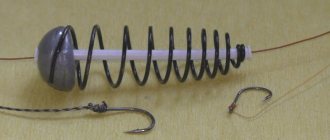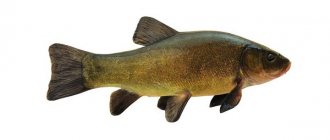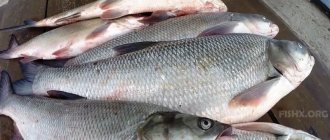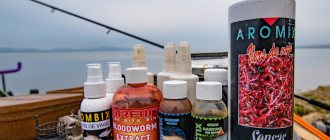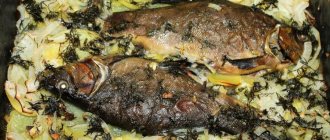Tench in autumn
Features of tench behavior in autumn can be summarized by the autumn months, or more precisely by characteristic weather conditions. In each region, you should pay attention to established temperature indicators and other weather changes over several days.
Lin in September. This month, fish move little around the reservoir. Lin prefers to lead a sedentary lifestyle. Only a lack of food forces it to move to another part of the reservoir. In September, there is still a rich food supply for tench: larvae, bottom insects and aquatic plants.
September is characterized by weather variability. The difference between night and day temperatures can reach 14 degrees. Strong gusty winds, prolonged rains and surges in atmospheric pressure are not uncommon phenomena in September. Such weather conditions have a negative impact on fish activity. The likelihood of a bite increases on warm, cloudy days. Drizzling rain is not an obstacle to tench fishing in September.
Lin in October. In mid-autumn, water and coastal vegetation begins to die off. Some benthic insects hide in the silt. But insects buried in silt are not a problem for tench. He finds them using his natural locator (whiskers). Air bubbles floating to the surface are a sign of the presence of tench, tearing benthic organisms out of the silt.
As the temperature drops, the line gradually moves to the bottom depressions. It lingers near reed thickets, where it eats the remaining aquatic vegetation. When fishing for tench in October, you should use bait, which is delivered to areas with differences in depth, located near reed islands.
Lin in November. After the first frost, the tench enters the bottom depressions (pits), in which they will live during the freeze-up period. The fish does not move far from wintering grounds, even on relatively warm days. The basis of tench's food in late autumn consists of the remains of aquatic vegetation and detritus (the remains of invertebrate animals).
In cold water, the metabolism in the tench's body slows down, but it continues to feed. When fishing for tench in November, you have to look for fish. Successfully placed bait in a wintering pit can attract inactive tench to the fishing site. A successful choice of place for tench fishing in the fall has a positive effect on the fishing result. This is also true when fishing for tench in winter.
basic information
With the arrival of autumn, mass rotting of algae begins, which are the usual summer shelter for tench. This phenomenon forces fish to get out of their shelters and migrate en masse to more promising points. These include clean spaces along the coastline, as well as water areas with remnants of reeds and other vegetation. If the fish stays close to the shore, it can be caught with a regular float rod.
When cold weather sets in, the tench activates an incredible appetite, which forces it to look for any source of food. This is another reason to immediately go fishing.
When searching for promising places for throwing gear, preference should be given to water areas with a depth of 2-2.5 meters, which are located at a short distance from thickets of reeds, cattails or reeds. Often such areas are located near the shore, so it is not necessary to use a boat for fishing. Tench can be caught using regular float gear.
Read: Catching tench. Subtleties of choosing a location, equipment and bait
When equipping a fishing rod, you do not need to comply with any specific requirements. Tench lack good eyesight and caution, but its bites are accompanied by strong jerks, so it is better to take powerful tackle with a good margin of safety. In addition, in the autumn, trophy representatives of the species begin to peck, reaching impressive body weight and size.
Unlike many other fish species, tench are characterized by a predictable lifestyle. Its movement routes may not change for years, which allows you to start fishing without using a bait mixture. The following is used as a hook attachment:
- Muckworm.
- Subleaf.
- Crayfish meat.
- Bloodworms.
Plant-type baits are practically ineffective, although in the summer they gave excellent results.
Choosing a place to catch tench in the fall
On an unfamiliar body of water, the choice of place for catching tench is carried out according to external signs. Then reconnaissance of the relief and bottom conditions is carried out. If favorable conditions for tench habitat coincide, you can start fishing. Signs of a promising place:
- Abundant coastal vegetation;
- Presence of emergent plants;
- Lush algae;
- Slow flow or no flow. On rivers there are low-flow bays, creeks and channel bends;
- Bottom turbidity rising to the surface along with air bubbles;
- Islands of reeds or other vegetation;
- Silted bottom;
- Depth changes;
- Bottom depressions (pits) in the coastal zone and near islands of vegetation sticking out on the surface of the water. Tench enter such places in late autumn.
Tench is not found in areas with a hard, silt-free bottom. Avoids fast channel currents and rapids.
Tench on a float rod in autumn
The equipment of a float rod for a tench is carried out taking into account the conditions of the upcoming fishing. Any type of float tackle is suitable. The most popular is the Bolognese fishing rod. Fishing for tench in the fall with a float rod is carried out from the shore or boat. Fishing features are taken into account when equipping a fishing rod:
- Rod. For fishing from the shore, rods with a length of 2.7 m to 6 m are suitable. The main thing is that its length ensures accurate casts. Models with a fast action are well suited for timely hooking (when shaken, only the tip bends). When fishing from a boat, the length of the rod does not play a special role;
- Coil. When retrieving caught fish, the reel plays an important role. For a float fishing rod for tench, spinning and inertial reels are suitable. The choice depends on the desire or habit of the angler;
- Fishing line. An inconspicuous fishing line is selected. The best option is fluorocarbon line. Its only drawback is its relatively high cost. Other high-quality fishing lines with a load capacity of at least 3 kg are also suitable. Selection principle: the thinner the better;
- Float. A blind rig or a sliding float is used;
- Sinker. It is important to load the float correctly. A single sinker or a spaced load with an underlay is used. Considering that tench fishing is carried out on a slight current, the second option is preferable;
- Leashes and hooks. Leashes are tied 10% thinner than the main line. Leash length 15-30 cm. Hooks No. 5-7 according to domestic numbering.
How to catch tench with a float rod
A prerequisite is compliance with masking. Otherwise, it will be possible to observe in clear water how the lines slowly move, not paying attention to the offered bait.
Casts are made into windows of coastal surface vegetation or algae. If they are absent, it is necessary to clear several coastal areas. Do not rake out all existing algae to reduce the likelihood of snags. It is enough to make a narrow (1.0-1.5 m) strip and cast the remaining algae under the border.
The tench bite has its own characteristics. First there is a slight twitching of the float, and then there is a lull. The next approach is characterized by a more active bite followed by moving the float to the side or under the water. Now, after the float has clearly shifted, you need to perform a sharp hook. The main thing is to break through the fleshy lip of the tench. When fishing, do not allow the fish to go into existing algae or reeds.
Tackle
Tackle for autumn tench fishing is practically no different from summer. The only difference is that for autumn fishing the tackle must be made of more durable material. Since autumn is the best time to catch large specimens of this type of fish. The following gear is used for fishing in the fall: • feeder; • float rod; • plug with plumb fitting. The choice of gear depends on the weather conditions on the day of fishing. In clear, windless weather, use a light float rod with ordinary hooks and fishing line. On gloomy, windy days, the bait on such gear will drag along the bottom, raising turbidity. Therefore, it is necessary to use heavier tackle. For this purpose, light float tackle is equipped with: • additional sliding weights; • fishing line with less windage; • special floats. Since fishing in late autumn involves long and accurate casts, one of the gears that has good catchability is a feeder. The feeder equipment should be as follows: • not a long rod (maximum 3.5 meters); • a small reel and spool that can hold 100 meters of fishing line; • cross-section of the main line 0.24-0.27 mm; • cross-section of the fishing line for the leash is 0.2 mm; • sinkers with a wire eye weighing from 7 to 15 g; • feeder feeder (installation occurs using a swivel and fastener.) • equipment for fishing with a feeder is carried out using a Gardner rig or a symmetrical loop. Fishing with a pole with a vertical nozzle means fishing using the “baking” method. When fishing with this rod, the bait is in motion, moving vertically or horizontally. The gear in this case looks like this: • long plug rod (at least 8 m); • cross-section of the main line 0.15-0.2 mm; • leash diameter 0.11-0.14 mm; • to soften the load on the top of the rod, a special universal shock absorber is attached inside the whale; • hooks are used from No. 2 to No. 7 depending on the bait used and the weight of the fish being caught; • the weight of the sinker depends on the presence and strength of the current in the reservoir and can vary from 10 to 25 grams. • long-keeled float with a bright tip and a small antenna.
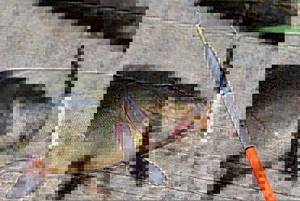
Fishing with such gear involves constant twitching of the rod. This can attract tench or, conversely, scare it away. Therefore, if no bites occur when manipulating the rod, you need to rethrow the tackle and hide, watching the float.
Tench on the feeder in autumn
The selected feeder rod should be comfortable for making accurate casts. The fishing line and reel are selected in the same way as for a float rod. Particular attention should be paid to choosing a feeder for the feeder. Fishing for tench in the fall using a feeder is carried out in silted areas. Therefore, you should select a feeder model made of lightweight material that allows it to remain on the surface of the bottom until the bait is washed out. To ensure casting, an additional sinker is used, which is tied below the feeder.
A slight burying of bait in the mud is acceptable. If she shows signs of life, then the tench will not leave her unattended. While eating complementary foods, he will not miss the opportunity to enjoy more attractive food. Tench does not leave room with enough food.
Catching tench on a feeder involves self-hooking the fish. To prevent “unpunished” eating of bait, you should pay attention to sharpening the tied hooks. Having felt the resistance of the bait, the cautious fish will refuse further attempts to capture it. The result is a “idle” bite.
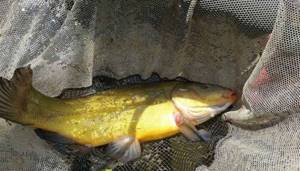
Tench in autumn on an elastic band
The elastic tackle is used for catching predatory and peaceful fish. Lin is no exception. Catching tench in the fall with an elastic band is possible before the onset of freeze-up. Fishing with a rubber band from a boat expands the possibilities of using this equipment.
When fishing with an elastic band, it is easier to determine what tench are biting on in the fall on the day of fishing. This is facilitated by the possibility of simultaneously placing all the baits in the arsenal on different hooks.
How to catch tench with an elastic band
The number of gear is limited by the conditions of the reservoir. The optimal quantity is 2-3 pcs. Gear is thrown to promising places at different distances. To flood hooks with bait to the bottom, you can additionally use a feeder, which is tied between the hooks on a longer leash. If the feeder is not used, the elastic band is equipped with leashes of different lengths. It is advisable to ensure that they do not overlap when the gear is in working position.
After determining the beginning of the bite, do not rush into hooking. You need to hook when the bite alarm is actively moving. If the weight at the other end of the tackle is not felt, then the elastic band returns to its original position. The caught fish is brought to the shore or boat on a constantly stretched line. The resisting line “sits” even more reliably on the hook. Even a short-term slack in the fishing line can provoke a fish escape. It happens in cases where the lip is not completely pierced with a hook.
How to fish for tench
It is worth remembering that it behaves differently at different times of the year. Without knowing this, catching tench is quite difficult and you can rarely hope for a serious trophy.
The long-awaited bite
In June, after spawning, a special hunger awakens; he grabs the bait without thinking, sharply sinking the float and causing the bell on the bottom to twitch. Even an experienced fisherman can confuse a bite with a perch bite. You can safely hook it - quickly and decisively, without letting it chew the worm, prick itself on the hook and spit it out. At other times, the tench takes the bait carefully and savors it for a long time. Be patient here - you need him to completely swallow the hook. Early hooking can lead to failure.
To learn more:
Selecting tees for balancers: the best manufacturers
Fishing for prey
Tench is a strong, persistent and stubborn fish, so a thin line with which you could easily fish out a half-kilogram roach is not suitable for catching resisting tench. It is advisable to choose a rod with a medium-hard whip - the tackle should respond to every movement of the angler. You need to fish carefully, but firmly. You should not allow the fish to swim behind snags or burrow into the ground - this will inevitably lead to the line breaking. You should be especially confident in pulling the prey towards you if you are fishing in reeds or water lilies - try to bring the tench to open areas so that you can easily pull it to the shore and place it in a landing net. By remembering these tips, you will probably return from autumn or spring fishing with a rich catch.
Bait for tench in autumn
Bait for tench is usually prepared based on personal experience. Even experienced fishermen constantly experiment with complementary food ingredients. As a basis, you can take a proven recipe for bait for tench in the fall. Ingredients:
- Steamed wheat – 1 part;
- Millet for bait – 1 part;
- Canned or prepared corn for fishing – 0.5 parts;
- Chopped worms, small maggots or bloodworms – 0.2 parts;
- A pinch of hemp seeds;
- A handful of crushed cake;
- Cottage cheese – 0.2 parts.
All ingredients are mixed on the shore. Soil and water from the reservoir are added. The bait is mixed to a consistency that ensures disintegration immediately after entering the water.
What do tench bite on in the fall?
Practical tench fishing shows that the best tench bite in the fall is observed with bait of animal origin:
- Dung worms;
- Bloodworms;
- Caddisfly larvae;
- Maggots.
In the first half of autumn, plant fishing baits should not be ignored. As the water temperature drops, tench are well attracted to bite on a hook, various combinations of bait and plant baits. When fishing for tench in cold water, preference is given to bait.
It should be noted that catching tench in the fall requires preliminary preparation of gear and taking into account the peculiarities of fishing. The correct choice of place for tench fishing also plays an important role. The correct technique for catching this wary fish is the key to successful fishing.
Lures and Lures
Tench prefers animal baits. The best is considered to be an earthworm or earthworm. It is rain and not manure. Because the earthworm is considered more hardy and tenacious and retains its activity on the hook longer, and it is also denser and more elastic than tench also likes. The worms are attached in bunches so that they form one large moving lump on the hook. Tench also does not disdain maggots and bloodworms.
Tench can also be caught on vegetable baits, such as bread or semolina, but this happens extremely rarely.

